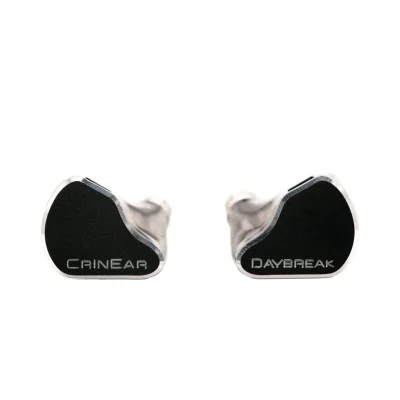Moondrop Blessing 3 and Crinear Daybreak use 2DD+4BA and 1DD+2BA+2mPT driver setups respectively. Moondrop Blessing 3 costs $320 while Crinear Daybreak costs $170. Moondrop Blessing 3 is $150 more expensive. Crinear Daybreak holds a slight 0.2-point edge in reviewer scores (7.1 vs 7.3). Crinear Daybreak carries a user score of 7.4. Crinear Daybreak has significantly better bass with a 1-point edge, Crinear Daybreak has better mids with a 0.9-point edge, Moondrop Blessing 3 has slightly better treble with a 0.4-point edge, Crinear Daybreak has significantly better dynamics with a 1.3-point edge, Crinear Daybreak has better details with a 0.8-point edge and Crinear Daybreak has significantly better imaging with a 1.3-point edge.
Insights
| Metric | Moondrop Blessing 3 | Crinear Daybreak |
|---|---|---|
| Bass | 6.6 | 7.6 |
| Mids | 6.7 | 7.6 |
| Treble | 6.6 | 6.2 |
| Details | 7.2 | 8 |
| Soundstage | 7 | 6.9 |
| Imaging | 6.5 | 7.8 |
| Dynamics | 6 | 7.3 |
| Tonality | 6.6 | 7.5 |
| Technicalities | 7 | 6.8 |
Moondrop Blessing 3 Aggregated Review Score
Average Reviewer Scores
Average Reviewer Score:
7.1Generally Favorable
Crinear Daybreak Aggregated Review Score
Average Reviewer Scores
Average Reviewer Score:
7.3Generally Favorable
Reviews Comparison
Moondrop Blessing 3 reviewed by Super* Review
Youtube Video Summary
Moondrop Blessing 3 sticks to the family recipe—clean, neutral, vocal-centric—while fixing the Blessing 2’s soft spot: treble extension. Cymbals finally have proper metallic sheen and decay, and the overall imaging/separation step up. Bass comes from a dual-DD setup that favors control over quantity: tight, springy, and articulate in the sub-bass without turning the set “bassy.” Vocals are outstanding for the price—transparent, textured, and front-and-center. Physically, it’s the familiar large 3D-printed acrylic shell with a slimmer ~5.7 mm nozzle for easier tip fit, glossy metal faceplates that love fingerprints, an improved but still slightly memory-prone cable, a chunky case, and lots of tips (but no Spring Tips). Price stays put at $320.
The one nitpick: a noticeable upper-bass/lower-mids scoop that trades warmth and body for clarity. With modern productions that already carry sub-bass, the presentation feels deep and precise; with leaner acoustic or classic rock, it can read a touch sterile. Versus peers: Blessing 2 is a hair warmer and fuller but less extended up top; Blessing 2 Dusk shares the mid scoop, adds more sub-bass, and keeps the older treble quirks; Soft Ears Studio 4 is similarly lean-neutral with a bigger stage but smoother BA timbre; Kiwi Ears Orchestra Light is warmer, punchier in mid-bass, and more laid-back with weaker separation. Even with the tonal quibble, this is a clear upgrade—a “nearly perfect” neutral set and an easy 5/5.
Super* Review original ranking
Super* Review Youtube ChannelBuy Moondrop Blessing 3 on Aliexpress
Ad
Price: $579
Buy Moondrop Blessing 3 on Aliexpress
Crinear Daybreak reviewed by Super* Review
2025-07-25Youtube Video Summary
The CrinEar Daybreak lands at $170 as the second IEM from Crinacle, positioned as a more accessible follow-up to the limited-edition Meta. This tribrid features a single dynamic driver, two balanced armatures, and two micro planars handling the highs. The build includes compact, semi-custom dark smoky resin shells offering good stability and comfort, though the molding might be slightly aggressive for some. The included cable provides swappable terminations (3.5mm and 4.4mm) but is noted for being somewhat stiff and kink-prone. Accessories are solid for the price, including a leatherette case and multiple tip options, with the stock silicones recommended for optimal fit due to the slightly longer nozzle.
Sonically, the Daybreak delivers what the review calls the best tonal balance yet within the popular "new meta" tuning category. Its frequency response is described as exceptionally neutral and natural from the mid-bass upwards, creating a low-contrast, chill, and non-fatiguing listen with forward, textured vocals and non-existent sibilance. However, this comes with trade-offs: the bass lacks ultimate tightness and slam, and the treble exhibits a light, wispy quality (likened to cotton candy) that lacks some bite and definition. While technical performance like imaging is solid, it doesn't stand out as exceptional.
In direct comparisons with six competitors around $200 (including the Meta, Binary x Chopin, EPZ P50, Ziigaat Lush, Truthear Pure, and Kiwi Ears KE4), the Daybreak consistently ranked highest for tonality. It was praised as a modern benchmark for natural tuning at its price. However, it fell behind in bass physicality and treble incisiveness. Ultimately rated a strong four stars, the Daybreak is highlighted as an excellent choice for those prioritizing a refined, natural midrange and easy listening experience over sheer technical prowess or visceral impact, earning the label of a "modern-day Etymotic ER2XR" with far better comfort.
Super* Review original ranking
Super* Review Youtube ChannelBuy Crinear Daybreak on Linsoul
Ad
Price: $169.99
Buy Crinear Daybreak on Linsoul
Moondrop Blessing 3 reviewed by Z-Reviews
Youtube Video Summary
Moondrop Blessing 3 ditches the old vibe for a fresh hybrid recipe: H.O.D.D.U.S. (two horizontally opposed 10 mm dynamics) plus 4× BA at around $320. The stage isn’t huge, by design—this is an intimate, in-the-head presentation that puts the music right up front. Bass is quick, tight, and more about responsiveness than brute slam; treble is crisp without splash, and nothing feels exaggerated. The crossover is impressively cohesive—no obvious handoff between DDs and BAs—yielding a “mixing/mastering” sort of neutrality with excellent detail retrieval and control. Think subtle-but-capable: delicate when it should be, instantly punchy when it must.
Build is peak Moondrop showpiece—shiny stainless backplate, clear acrylic shell showing the guts, and a comfy fit—but the stock 3.5 mm cable is underwhelming. The box is over-engineered fun; the tips selection is one silicone type in many sizes (foam not ideal here). Tip rolling to something like Dunu S&S keeps bass honest. Amp pairing prefers clean, linear gear; warm hybrids can push mids oddly, while neutral solid-state keeps things balanced. Not hard to drive (~12 Ω). Skip if you crave gobs of soundstage; absolutely grab if the goal is a neutral, close-up, fast, and coherent listen that “force-feeds” the music—without the fatigue. A confident buy for presence and precision.
Z-Reviews Youtube Channel
Crinear Daybreak reviewed by Z-Reviews
2025-08-23Youtube Video Summary
The Crinacle Daybreak is a technically excellent IEM that offers exceptional clarity and detail retrieval without being fatiguing. Its five-driver configuration delivers a cohesive and precise sound signature that is clean, flat, and incredibly balanced. The bass is present and punchy but never exaggerated, making it a perfect tool for studying music and hearing every nuance in a recording.
However, this precision comes at the cost of fun. The tuning is described as a little dry and somewhat intimate, lacking the expansive soundstage and flavorful character that makes other IEMs more engaging for pure enjoyment. While the build is solid with an acceptable cable and nice connectors, its looks are admittedly boring. It’s a perfectly cooked meal that follows the recipe without any surprises.
Ultimately, the Daybreak is a highly respected and much-loved IEM that fills a specific niche for a clean, reference-like sound. It’s a business suit of an IEM, but it wouldn't be the first choice for someone looking for a more exciting, fun, or "f***ed up" sound signature to get them moving. It commands respect for its technical merits, even if it isn't to everyone's personal taste.
Z-Reviews Youtube Channel
Moondrop Blessing 3 reviewed by Jaytiss
Youtube Video Summary
The Moondrop Blessing 3 is a 2DD + 4BA hybrid with a larger, premium-feeling shell that remains surprisingly comfortable—though size could be an issue for smaller ears. Accessories and build echo Moondrop’s recent releases (even the analog cable mirrors the Dusk’s), underscoring a cohesive design philosophy. Tuning skews a touch brighter and more analytical: airy upper-mids/treble, crisp detail retrieval, and clean separation, with lighter bass impact than some rivals. It’s a set that showcases “technicalities” in an immediately noticeable way.
Against the Crinacle x Moondrop Dusk, Blessing 3 trades some punch and warmth for extra sparkle and detail; Dusk offers more bass, slightly calmer treble, and a touch more “slam,” while Blessing 3 sounds airier and more incisive. Versus Variations, the graphs are similar and they trade blows, but Variations’ bass advantage struggles to justify the higher price for most listeners. Compared to Moondrop’s more affordable options (e.g., Aria 2) and value picks like TruthEar Hexa or AFUL’s Magic One, Blessing 3 delivers a more refined treble presentation and step-up resolution, while some mid-fi competitors around ~$600 don’t clearly outpace it in engagement or detail.
Priced ~$330 (often on sale around $280), Blessing 3 sits at the sweet spot before diminishing returns hit hard. The trade-offs are clear: a touch bright, bass-light for those craving heft, and not the absolute value king next to Dusk—but as an airy, detailed, well-built daily driver, it’s easy to recommend. Final call: a strong A-—especially fitting for treble-heads and anyone seeking a clean, modern Moondrop tuning without paying flagship prices.
Jaytiss Youtube Channel
Crinear Daybreak reviewed by Jaytiss
2025-07-31Youtube Video Summary
The CrinEar Daybreak features a metal nozzle and metal faceplate with comfortable contours, though the fit is noted as a bit dainty and small. Isolation is practically non-existent, and the fit isn't particularly secure. The included cable looks nice and photographs well, featuring interchangeable terminations for versatility, but its chin slider moves too easily and isn't recommended for those needing a functional one. The case is deemed aesthetically pleasing and feels good, though not especially premium, magnetically shutting with adequate space.
Sonically, the Daybreak leans boring and somewhat sterile or dry. It offers nice bass and a lot of upper mids, which are done decently with a standard 3K peak. However, the combination of this upper-mid focus and an incisive peak around 8K contributes to a perceived harshness and sharpness, lacking in overall detail retrieval. Graph comparisons reveal its signature has significantly more upper mids and often more bass than competitors like the Moondrop Dusk or TruthEar Nova, resulting in a less engaging listen. Sets like the Defiant, Chopin, and Performer 7 are cited as more engaging alternatives at similar or lower prices, with the Defiant specifically recommended over the Daybreak. Even the Punch Audio martillo and Moondrop Meteor, sharing driver configurations, are considered more fun or better tuned.
Ultimately, the Daybreak is a solid A-minus IEM, well-packaged and a commendable first effort for the brand, but it's not hypeworthy or a benchmark. It lacks imagination and falls short against numerous compelling alternatives around its price point, such as the Performer 7, ZOS Defiant, Chopin, or discounted planar options like the Aether. While a good value, especially if found on sale via Linsoul or the used market, its piercing upper mids and failure to truly excel make it hard to fully recommend over the competition.
Jaytiss Youtube Channel
Moondrop Blessing 3 reviewed by Jays Audio
Youtube Video Summary
Moondrop Blessing 3 brings excellent resolution, clarity, and layering, with a clean, transparent tonality that skews bright-leaning neutral. Treble is extended without being splashy, giving plenty of air to cymbals and female vocals, while the midrange stays unmasked and articulate—piano and guitar transients pop with crisp decay. Staging is open and airy with pinpoint imaging (not wrap-around holographic like the biggest stage monsters), and the bass is snappy, tight, and bleed-free. The catch: the low end sits back, so on certain tracks the presentation can feel light, and a 6 kHz rise can get spicy at louder volumes depending on the song; vocals may lean a touch thin in classic Moondrop fashion.
Compared to Blessing 2, it’s a clear step up in cleanliness, note definition, and separation. Versus Dusk, think side-grade: a slightly brighter tilt and less bass weight, trading some low-end texture/extension for more air and edge definition. The set responds very well to EQ—a ~+5 dB low shelf @ 60 Hz (Q 0.5) and about −1.5 dB @ 6 kHz (Q 3) adds punch and reins in glare; with this, it approaches Variations performance while filling in mid-bass a bit. Simple nozzle filters (e.g., Alina/Tanchjim-style) can also tame upper mids and nudge bass up. For listeners who want more slam and tamer highs, stock tuning won’t be the endgame; for those preferring a clean, airy, detail-forward neutral, Blessing 3 is pretty banging at its price and technically competitive with pricier sets (think RS5, Oracle, even EGL7M on technicals, though the latter still stages wider). If Moondrop’s house sound clicks, it’s an easy rec; if not, look at cheaper options like Hexa or keep an eye out for a potential B3 “Dusk” variant.
Jays Audio Youtube Channel
Crinear Daybreak reviewed by Jays Audio
2025-07-16Youtube Video Summary
The CrinEar Daybreak offers a balanced, clean, and non-fatiguing sound signature, functioning effectively as an all-rounder. Every frequency region is solid, delivering a smooth presentation without harshness or overwhelming warmth. The bass provides a slight sub-bass rumble and integrates cleanly into the mids, avoiding bleed, though it lacks significant impact, slam, or deep texture. Similarly, the mid-range and vocals are well-separated and forward enough, free from congestion or odd timbre, but don't specialize. The treble has enough extension and air, avoiding darkness or excessive sharpness, but misses out on micro-detail, sparkle, and expansive staging. It’s a decent, inoffensive performer across the board, described aptly as a "very good vanilla ice cream cone".
Technically, the Daybreak is competitive but not class-leading. Sets like the Meta, Ziigaat Crescent, Kiwi Ears Astral, Simgot EM6L, or TruthEar Nova offer slightly better detail retrieval, imaging, and resolution. Its main challenge comes from remarkably similar competitors, particularly the EPZ P50 and SLIIVO SL224, which share nearly identical tuning, driver configurations, and technical performance around the same $160-$180 price point. The P50 leans slightly more vocal-centric, while the SL224 offers marginally better bass texture and treble detail (though costing more). If you already own either, the Daybreak becomes largely redundant. Against alternatives like the bassier, more dynamic Ziigaat Odyssey ($200), the Daybreak feels safer but less engaging at higher volumes. Compared to Harman-tuned sets like the Supermix 4, Chopin, or Nova, the Daybreak boasts fuller tonality and less fatigue but gives up some layering and detail.
Ultimately, the Daybreak is a competent, well-packaged all-rounder at $170, delivering a balanced and inoffensive listen suitable for any genre library. However, it fails to stand out uniquely in a crowded field. Its sound signature is replicated almost exactly by the existing P50 and SL224. While it earns a half recommendation as a solid option for those seeking a non-fatiguing all-rounder who *don't* own those twins, it's unlikely to become a favorite due to its lack of distinctive character. Value is decent, but alternatives offer more specialization or technical prowess for similar or lower cost.
Jays Audio Youtube Channel
Moondrop Blessing 3 (more reviews)
Moondrop Blessing 3 reviewed by Tim Tuned
Youtube Video Summary
Moondrop Blessing 3 steps up as the most complete Blessing yet—cleaner and more controlled than the Blessing 2: Dusk, with less bass quantity but sharper dynamics and a tidier lower-midrange. It avoids the slight thinness some hear on Variations, keeping notes lean but satisfying. The midrange stays beautifully natural and a touch energetic without shout, while the biggest upgrade is in the treble: retaining the Dusk’s natural decay yet adding more air, so micro-details pop and vocals take center stage. The overall tilt is more vocal-forward and detail-focused than Dusk.
On the technical front, resolution sits around—or a notch above—the Timeless, with an impressively wide stage helped by reduced bass bleed and boosted upper air. Micro-detail is present but not laser-etched; separation could use that last half-step of incisiveness. Still, imaging, control, and clarity make for an easy “wow” on first listen, especially for listeners who value clean layering over sheer slam.
Comparisons are straightforward: versus the original Blessing 2, this is an upgrade across the board—cleaner lows, punchier bass quality, better lower-treble timbre, and comparable air. Versus Blessing 2: Dusk, choose Dusk for a more balanced and fuller bass hit; pick Blessing 3 for vocal presence, detail, and control. Against SoftEars Studio 4, Studio 4 sounds about a half-step more balanced with a touch more bass fullness and slightly better timbre, but the Blessing 3’s performance at roughly $320 is seriously competitive for the class. After a few underwhelming Moondrop releases, this feels like reclaiming the throne—a highly recommended return to form.
Tim Tuned Youtube Channel
Moondrop Blessing 3 reviewed by Shuwa-T
Moondrop Blessing 3 reviewed by Yifang
Youtube Video Summary
Moondrop Blessing 2:Dusk brings a rock-solid build with clear acrylic shells that show off the 1DD+4BA internals and that cheeky anime engraving. Fit skews large—big nozzles and a bulky body—so smaller ears may struggle. The included “sweat guards” are basically stickers that tend to come off with the tips, and taking these to the gym is a bad idea (moisture can cause issues). The real sin is the stock cable: thin, microphonic, and fragile—swap it immediately. On the upside, customer service/warranty is legit if something goes wrong.
Sonically, this tuning is a crowd-pleaser. The bass extends deep for a DD and slams without bleeding, the mids are the highlight—acoustic instruments and vocals sound fantastic—and the treble is clean but can push toward fatigue for sensitive listeners or on bright EDM drops. For electronic genres (hardstyle, D&B), the low-end grip is addictive; for orchestral and vocal music, it’s as close to “set and forget” as it gets. Quick fix if the top end nudges too hot on desktop: a simple EQ cut—~−4.5 dB @ 8 kHz (Q≈1)—tames the edge and lets the volume come up for extra bass satisfaction.
Technical chops are strong: resolution pops micro-details without turning clinical, soundstage width sits in the higher percentile for the price, and dynamics swing convincingly from soft to slam. Imaging is fine, but positional distance (for Valorant/CS-style footsteps) isn’t the strength—Apex/Overwatch or media use is totally fine. Net takeaway: as an everyday all-rounder for music, games, and movies around this bracket, it’s a killer pick with just two caveats—skip the stock cable and avoid sweaty workouts—or EQ the treble if sensitive.
Yifang Youtube Channel
Moondrop Blessing 3 reviewed by Gizaudio Axel
Gizaudio Axel original ranking
Gizaudio Axel Youtube ChannelMoondrop Blessing 3 reviewed by Precogvision
Precogvision Youtube Channel
Moondrop Blessing 3 reviewed by Nymz
Moondrop Blessing 3 reviewed by
 Fresh Reviews
Fresh Reviews
Youtube Video Summary
Moondrop’s Blessing 3 pushes a distinctly airy, high-clarity take on competitive audio. The stage feels a touch farther from the head, with solid imaging, depth perception, and verticality, but it walks the edge of “how far is too far” for games like Valorant and Apex. Detail retrieval up top is crisp and separation of higher-frequency cues is clean, yet the set could use a bit more immediacy and extra sub-/mid-bass to weight deep thumps and footsteps. Once ears adjust, performance is strong, though the bright tilt can be fatiguing for some. The see-through shell with a metallic faceplate is slick; accessories are fine but basic at this price ($310), with tips and cable that invite swapping.
Against Dunu’s SA6 MK2, the Blessing 3 sits on the “open/bright” end while the Dunu plays “closer/warmer,” delivering more urgency from its fuller low end—but that extra mid-bass can blur layering and separation when many similar cues trigger at once. For pure game sense, both have Wallhack Certified potential, just not near the top; sets like Kiwi Ears Orchestra Light (V2) strike a smarter middle ground with better balance for mixed scenarios, and options such as Dunu Vulkan or Raptgo Hook-X can edge them out. Ergonomics are good on both; the SA6 MK2’s “Mini Hulk” cable and swappable plugs (4.4/2.5/3.5) and generous tip spread help justify its higher tag ($579). Summary: choose Blessing 3 for a brighter, wider, cue-separating presentation; choose SA6 MK2 for a nearer, meatier hit—while the Orchestra Light V2 remains the safer, game-first recommendation.
Fresh Reviews original ranking
Fresh Reviews Youtube ChannelMoondrop Blessing 3 reviewed by Head-Fi.org
Crinear Daybreak (more reviews)
Crinear Daybreak reviewed by Audionotions
Crinear Daybreak reviewed by Fox Told Me So
2025-09-26This is it.
Crinear Daybreak's tuning follows the New Meta family with two quirks: a dip at 400 Hz that slightly thins male vocals, and a dip around 8 kHz that smooths treble but softens cymbals/overtones. Otherwise it’s safe, balanced, and within preference bounds.
Bass has moderate body with audible rumble and quick decay, though slam could hit harder; Mids sit neutral, neither pushed nor recessed, keeping instruments evenly balanced; Treble rolls off smoothly—pleasant, but lacks the final lift that would open it up. Resolution is average for the price: clear layers but compressed depth, like a lasagna being pressed flat.
Within the $169 bracket, Daybreak is neutral, natural, and non-fatiguing—an easy daily driver.
Fox Told Me So original ranking
Fox Told Me So Youtube ChannelCrinear Daybreak reviewed by Web Search
2025-07-25The CrinEar Daybreak is a tri-brid IEM built around a 5-driver array—1DD + 2BA + 2 micro-planar tweeters—with a moderate 20 Ω load and 105 dB/mW sensitivity, making it easy to drive from portable sources. MSRP sits at $169.99, placing it squarely in the competitive mid-budget segment. These core specs are confirmed on the official product page and retail listings.
Tonally, Daybreak trends toward neutral with a mild sub-bass lift and restrained warmth, but listener experience can swing with tip choice. Multiple independent impressions note a touch of upper-mid / lower-treble energy (ear-gain region) on stock narrow-bore tips, which relaxes with wide-bore options; overall midrange balance and resolution are strong for the price. These observations are echoed in in-depth evaluations and measurements from Headphones.com’s reviews.
Build is a resin shell with metal faceplate and a compact pseudo-custom profile; comfort is generally good, though the 6 mm nozzle and angle may not be ideal for every ear. Accessory quality is serviceable—SPC cable with interchangeable 3.5 mm / 4.4 mm terminations, a leatherette case, and basic tips—leaving room for aftermarket tip rolling to fine-tune treble behavior and staging. These physical details and inclusions are documented by the maker and retailers.
Moondrop Blessing 3 Details
Driver Configuration: 2DD+4BA
Tuning Type: Neutral
Brand: Moondrop Top Moondrop IEMs
Price (Msrp): $320
Support our free service! Buying through our affiliate links costs you nothing extra:
Crinear Daybreak Details
Driver Configuration: 1DD+2BA+2mPT
Tuning Type: Neutral with Bass Boost
Brand: CrinEar Top CrinEar IEMs
Price (Msrp): $169.99
Support our free service! Buying through our affiliate links costs you nothing extra:
Moondrop Blessing 3 User Review Score
Average User Scores
Average User Score: n/a
Based on 0 user reviews
No user reviews yet. Be the first one who writes a review!
Crinear Daybreak User Review Score
Average User Scores
Average User Score:
Based on 1 user reviews
7.4Generally Favorable
Moondrop Blessing 3 Gaming Score

Gaming Score & Grade
- The gaming score is prioritizing technical capabilities of the IEM (Separation, Layering, Soundstage) and good value.
Gaming Score
6.8Gaming Grade
B+Crinear Daybreak Gaming Score

Gaming Score & Grade
- The gaming score is prioritizing technical capabilities of the IEM (Separation, Layering, Soundstage) and good value.
Gaming Score
7Gaming Grade
A-Moondrop Blessing 3 Scorings
Average Technical & Tuning Grades
Average Tunign Grade
B+- Expect a friendly tonal balance that could use polish but remains inviting. Great for casual listening, less so for purists.
Average Technical Grade
A-- Overall technicalities are acceptable, delivering enough clarity for casual sessions. Imaging is serviceable though not immersive.
Crinear Daybreak Scorings
Average Technical & Tuning Grades
Average Tunign Grade
A- Tuning lands in a pleasing sweet spot with mostly coherent frequency integration. Tonality stays consistent from track to track.
Average Technical Grade
B+- The presentation is steady if unspectacular, holding onto essential details when the music stays simple. Fine details occasionally slip through the cracks.
Moondrop Blessing 3 User Reviews
"This is an example review"
Pros
- Example pro 1
- Example pro 2
Cons
- Example con 1
- Example con 2
Share your experience and build your personal ranking list.
You need to be signed in to write your own reviewCrinear Daybreak User Reviews
Share your experience and build your personal ranking list.
You need to be signed in to write your own reviewA well-toned, easy-listening IEM that excels at midrange clarity even if it doesn’t dazzle technically.
Pros
Balanced and non-fatiguing tuning with smooth, natural mids.Cons
Bass lacks slam and treble can feel veiled or lacking crisp sparkle.Find your next IEM:
IEM Finder Quiz
newIEM Comparison Tool
newVS































